#Ca. 1479–1425 B.C.
Text
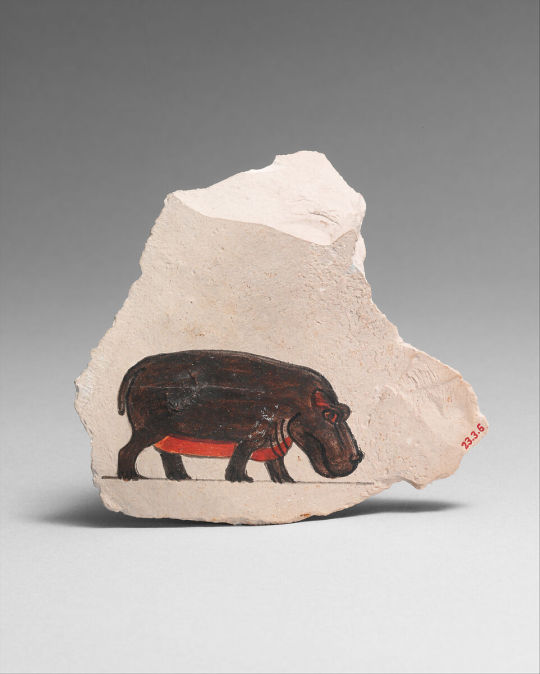
Artist's Painting of a Hippopotamus
Ca. 1479–1425 B.C.
New Kingdom.
The hippopotamus on this ostracon was painted with the sure hand of a skilled artist who had no need of a grid. Other ostraca in the collection were clearly made as templates to be used when transferring an image to the wall of a tomb or a temple or as practice pieces. The purpose for this sketch and others is less clear.
#Artist's Painting of a Hippopotamus#Ca. 1479–1425 B.C.#new kingdom#art#atist#art work#art world#art news#ancient art#archeology#archeolgst#history#history news#ancient history#ancient culture#ancient civilizations#ancient egypt#egyptian history#egyptian mythology#egyptian art
172 notes
·
View notes
Text


~ Finger stall.
Period: New Kingdom, Dynasty 18; reign of Thutmose III
Date: ca. 1479–1425 B.C.
Place of origin: Egypt, Upper Egypt, Thebes, Wadi Gabbanat el-Qurud, Wadi D, Tomb of the Three Foreign Wives of Thutmose III
Medium: Gold
#ancient#ancient art#history#museum#archeology#ancient egypt#ancient sculpture#ancient history#archaeology#egyptology#egyptian#egypt#finger stall#finger#18th dynasty#new kingdom#thutmose iii#thebes#ca. 1479 b.c.#ca. 1425 b.c.#gold
457 notes
·
View notes
Photo

Unknown, Artist's Painting of a Hippopotamus
New Kingdom
ca. 1479–1425 B.C.
The hippopotamus on this ostracon was painted with the sure hand of a skilled artist who had no need of a grid. Other ostraca in the collection were clearly made as templates to be used when transferring an image to the wall of a tomb or a temple or as practice pieces
Broadly speaking, the Egyptians viewed the world in terms of the opposing forces of order and chaos, and they recognized these forces in the creatures around them. In its benign aspect, the hippopotamus, standing upright, was used to represent the goddess Taweret the protector of children and pregnant women. But the hippo could also be a dangerous, destructive beast, and the Egyptians had great respect for its power. In its destructive aspect, the hippo was a stand-in for Seth, the god of chaos, and scenes of the king, or the god Horus, or even a deceased tomb owner harpooning a hippopotamus can be read as depictions of the triumph of order over chaos. In this small painting, however, the animal is not shown in an aggressive pose. In this case the image may simply be what meets the eye: a representation of a hippopotamus.
met museum
274 notes
·
View notes
Text


Mirror with Hathor Emblem Handle, New Kingdom ca. 1479–1425 B.C., silver disk with a wood (modern) handle sheathed in gold; modern inlays, 13 1/8 x 15.5 x 13/16 in (33.4 x 15.5 x 2 cm)
7 notes
·
View notes
Photo
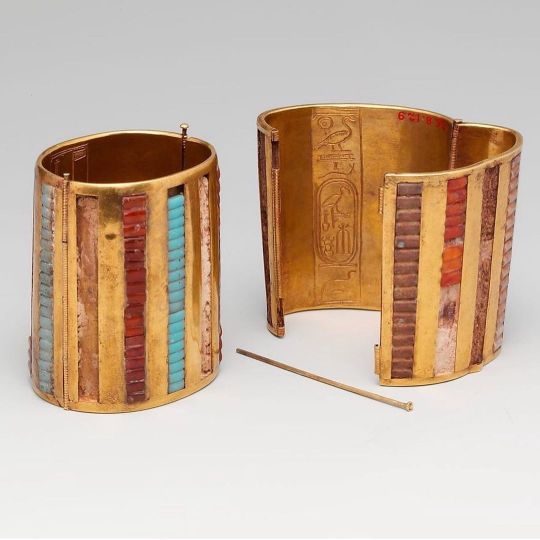
Hinged Cuff Bracelet (ca. 1479–1425 B.C.) Three pairs of hinged bracelets are associated with the tomb 𓂝𓂝𓇋𓉴 “ˁˁı͗” of three foreign wives 𓈞𓏏𓏫 “ḥm.tw” of Thutmose III. They are all made of burnished gold 𓋞 “nbw” inlaid with carnelian 𓁷𓂋𓋴𓏏𓈒𓏫 “ḥrst” and glass 𓃀𓆓𓏸𓅱 “bḏ” that was originally turquoise 𓅓𓆑𓂓𓏏𓏬 “mfk.t” and dark blue 𓇋𓁹𓅂𓈒𓏫 “irtyw”, but has faded. Each is inscribed on the inner surface with the cartouches 𓍲𓈖𓏌𓅱𓍶 “šnw” and epithets of Thutmose III (𓅝𓄟𓊃𓄤𓆣𓏫) “ḏhwty-ms nfr-ḫprw” ‘Thutmoses (Born of Thoth), Beautiful of Forms’ suggesting that they were a gift of the king 𓇓𓏏𓈖 “nsw.t”. Translation: (Left) The Good God, Lord of the Two Lands, Menkheperre, Given Life. “nṯr-nfr nb t3wy mn-ḫpr-rˁ dı͗ rˁ” (Right) Son of Ra, of his body, Thutmoses-Beautiful of Form, Forever. “s3-rˁ n ḫt.f ḏhwty-ms nfr-ḫpr ḏ.t” Object Details Title: Hinged Cuff Bracelet Period: New Kingdom Dynasty: Dynasty 18 Reign: reign of Thutmose III Date: ca. 1479–1425 B.C. Geography: From Egypt, Upper Egypt, Thebes, Wadi Gabbanat el-Qurud, Wadi D, Tomb of the Three Foreign Wives of Thutmose III Medium: Gold, carnelian, turquoise, glass Dimensions: h. 7.2 cm (2 13/16 in); w. at top 6 cm (2 3/8 in); d. at top 4.8 cm (1 7/8 in). Location: Metropolitan Museum of Fine Arts 𓋹𓎬𓋹𓎬𓋹𓎬𓋹𓎬𓋹𓎬𓋹𓎬𓋹𓎬𓋹𓎬𓋹𓎬𓋹𓎬𓋹𓎬𓋹𓎬𓋹𓎬𓋹𓎬𓋹𓎬𓋹𓎬 📸 @egyptologylessons 𓋹𓊽𓋴𓆖𓎛𓇳𓎛 © (📸 @metmuseum and description) 𓊁𓊁𓊁𓊁𓊁𓊁𓊁𓊁𓊁𓊁𓊁𓊁𓊁𓊁𓊁𓊁𓊁 #Egypt #egyptian #ancient #ancientegypt #hieroglyphics #ägypten #thisisegypt #egyptologist #myegypt #egyptianhistory #egyptology #explore #hieroglyphs #madeinegypt #egypte #egyptians #egyptshots #loveegypt #discoveregypt #egitto #埃及 #مصر #egipto #explorepage #met #thutmosesiii #egyptianjewelery https://www.instagram.com/p/CeBkyqpu9fS/?igshid=NGJjMDIxMWI=
#egypt#egyptian#ancient#ancientegypt#hieroglyphics#ägypten#thisisegypt#egyptologist#myegypt#egyptianhistory#egyptology#explore#hieroglyphs#madeinegypt#egypte#egyptians#egyptshots#loveegypt#discoveregypt#egitto#埃及#مصر#egipto#explorepage#met#thutmosesiii#egyptianjewelery
16 notes
·
View notes
Video
Posted @withregram • @egyptologylessons Broad Collar ca. 1479–1425 B.C. New Kingdom By the New Kingdom, broad collar necklaces were the most frequently worn pieces of jewelry among the royalty and elite in ancient Egypt. This necklace belonged to one of three foreign wives of Thutmose III. The king's name is inscribed on the backs of the falcon-headed terminals indicating that it was a gift from him to his wife. 𓋹𓎬𓋹𓎬𓋹𓎬𓋹𓎬𓋹𓎬𓋹𓎬𓋹𓎬𓋹𓎬𓋹𓎬𓋹𓎬𓋹𓎬𓋹𓎬𓋹𓎬𓋹𓎬𓋹𓎬𓋹𓎬 📸 @egyptologylessons 𓋹𓊽𓋴𓆖𓎛𓇳𓎛 © (@metmuseum and description) 𓊁𓊁𓊁𓊁𓊁𓊁𓊁𓊁𓊁𓊁𓊁𓊁𓊁𓊁𓊁𓊁𓊁 #Ancientegypt #ägypten #egyptianhistory #egyptology #hieroglyphs #egypte #egitto #埃及 #مصر #egipto #이집트 #collar #egyptianjewelry #falcon #metropolitanmuseumofart (at The Metropolitan Museum of Art, New York) https://www.instagram.com/p/CgKXBsUrZ4y/?igshid=NGJjMDIxMWI=
#ancientegypt#ägypten#egyptianhistory#egyptology#hieroglyphs#egypte#egitto#埃及#مصر#egipto#이집트#collar#egyptianjewelry#falcon#metropolitanmuseumofart
9 notes
·
View notes
Text
Animals at the Met!
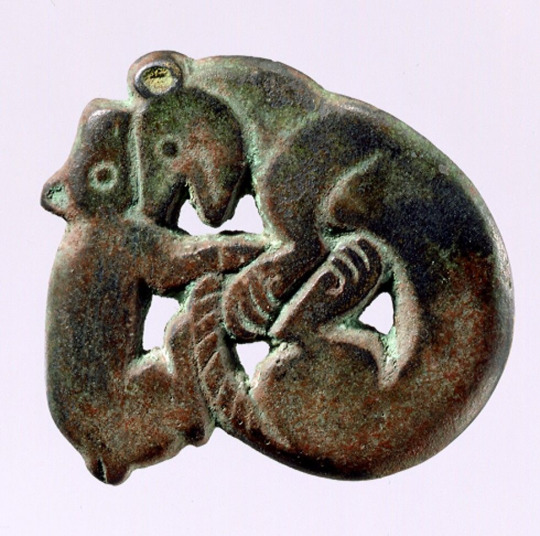
Garment Plaque with Leopard and Bear, Northwest China, 5th–4th century B.C.
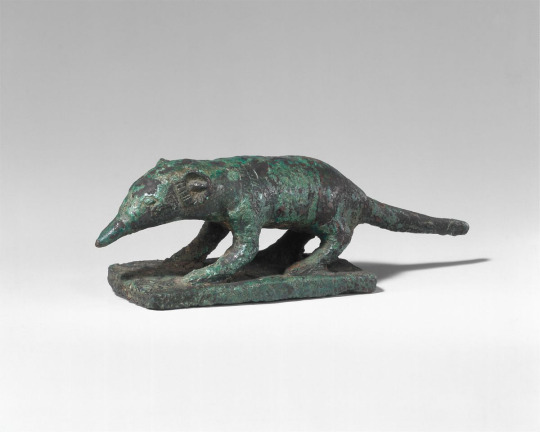
Shrew, Egypt, 304 B.C.–30 B.C.
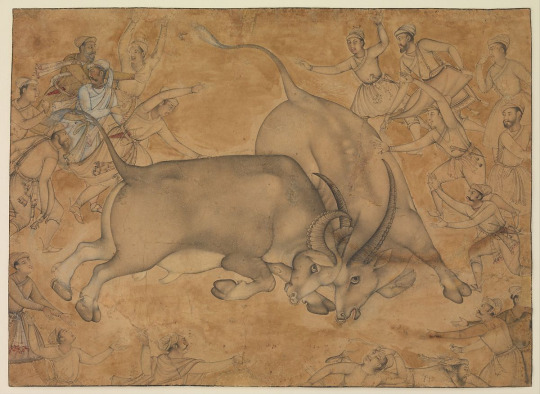
Buffaloes in Combat, India, late 16th century

Artist's Painting of a Hippopotamus, Egypt, ca. 1479–1425 B.C.

Terracotta zoomorphic askos (vessel), Cypriot, 1900–1600 B.C.
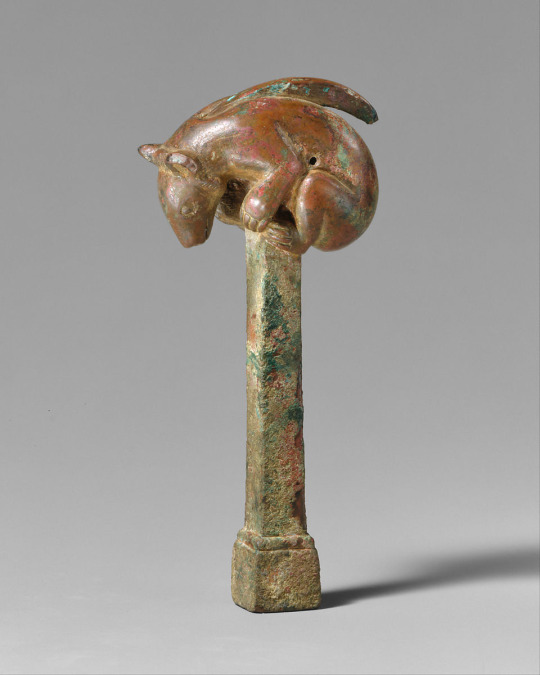
Tuning Key for a Zither, North China, 3rd century B.C.
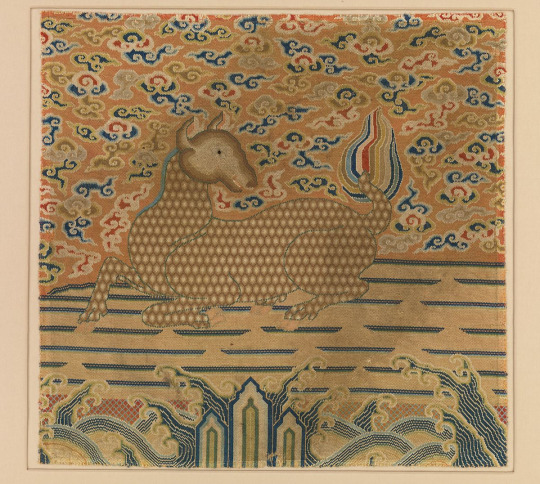
Rank Badge with Qilin, China, 16th–early 17th century
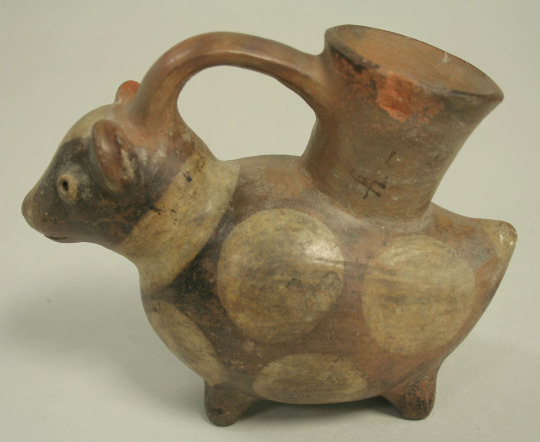
Animal Bottle, Peru, A.D. 200–900
3 notes
·
View notes
Text
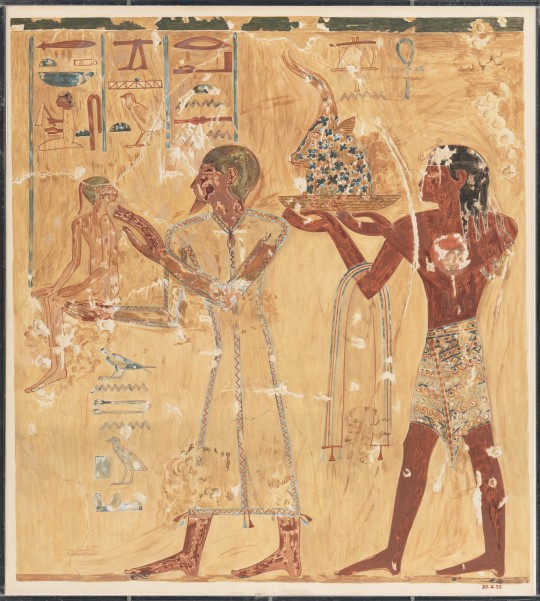
Foreigners, Tomb of Menkheperraseneb - Met Museum Collection
Note: This is a modern copy of an original
Inventory Number: 30.4.55
Original Dating: New Kingdom, Dynasty 18, ca. 1479–1425 B.C.
Location Information: From Egypt, Upper Egypt, Thebes
Description:
This facsimile copies a detail from a scene of foreigners in the tomb of Menkheperresonb (TT 86) in the necropolis of western Thebes. The painting depicts two foreigners in a precession: the first is a Syrian; the second is from Crete. Each is identified by his attire and hairstyle. The facsimile was painted at the tomb in 1925 by Nina de Garis Davies, a member of the Graphic Section of the Museum's Egyptian Expedition.
#Foreigners#Tomb of Menkheperraseneb#new kingdom#new kingdom pr#dynasty 18#upper egypt#thebes#met museum#30.4.55#NKPRForeigners
0 notes
Text
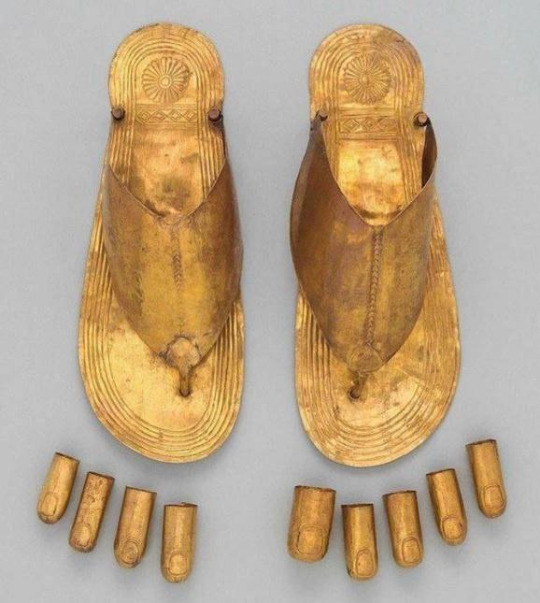
are.na/block/12849638
These sandals were part of the funerary equipment belonging to one of three foreign wives of Thutmose III. They are made of thin gold sheet that would not have withstood normal wear; they were intended for funerary use only. The sandals are decorated with details intended to imitate the decoration on leather sandals.
ca. 1479–1425 B.C.
1 note
·
View note
Photo




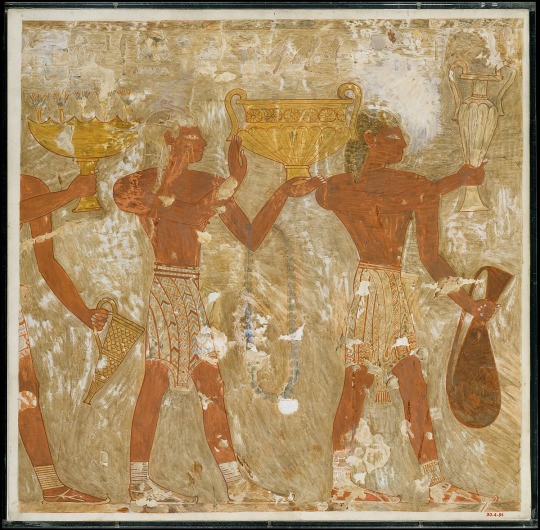

Ancient Minoans, as depicted by ancient Egyptians. Egyptians called the island of Crete “Keftiu”
1. Minoan envoys on the tomb of User (on left) and Rekhmire (on right)
2-3. Minoan procession from tomb of Rekhmire
4. Minoan procession, recording of gifts from Keftiu by the Egyptian officials, from the tomb of Rekhmire
5-6. Cretans Bringing Gifts, Tomb of Rekhmire ca. 1479–1425 B.C., facsimile painting by Nina de Garis Davies
211 notes
·
View notes
Photo

Stamp-seal, ca. 1479–1425 B.C., Brooklyn Museum: Egyptian, Classical, Ancient Near Eastern Art
Size: 1/4 x 1 x 1 3/8 in. (0.6 x 2.6 x 3.5 cm)
Medium: Steatite, glaze
https://www.brooklynmuseum.org/opencollection/objects/56772
9 notes
·
View notes
Text

Sculptors at Work, Tomb of Rekhmire, ca. 1479–1425 B.C. New Kingdom. reign of Thutmose III–early Amenhotep II, tempera on Paper, by Nina de Garis Davies (1881–1965).
The original mural comes from Upper Egypt, Thebes, Sheikh Abd el-Qurna, Tomb of Rekhmire.
4 notes
·
View notes
Text

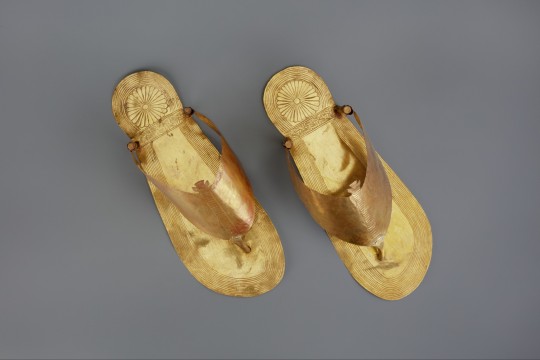

~ Sandals.
Period: New Kingdom, 18th Dynasty; Reign of Thutmose III
Date: ca. 1479–1425 B.C.
Place of origin: Egypt, Thebes, Wadi Gabbanat el-Qurud, Wadi D, Tomb of the Three Foreign Wives of Thutmose III
Medium: Gold sheet
#ancient#ancient art#history#museum#archeology#ancient egypt#ancient history#archaeology#egyptian#egypt#egyptology#sandals#gold#new kingdom#18th dynasty#thutmose iii#ca. 1479 b.c.#ca. 1425 b c.
1K notes
·
View notes
Photo
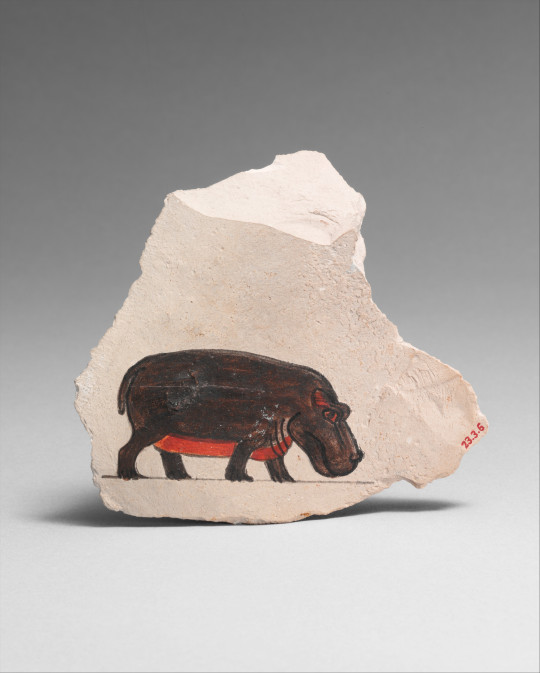
Painting of a Hippopotamus, Thebes, Egypt, ca. 1479–1425 B.C.
Limestone, today at Metropolitan Museum of Art, 10.8x 12 cm
Source: Metropolitan Museum of Art / public domain
#ostraca#Ancient Egypt#metropolitan museum of art#hippo#africa#limestone#secular#15th century BC#ok not really a wall painting#sketch
138 notes
·
View notes
Photo

Ostracon with Artist’s Painting of a Hippopotamus #Egypt, #Thebes, ca. 1479–1425 B.C. https://www.instagram.com/p/CGu9WJAl-pV/?igshid=1l9f2jkqtt1v7
49 notes
·
View notes
Photo
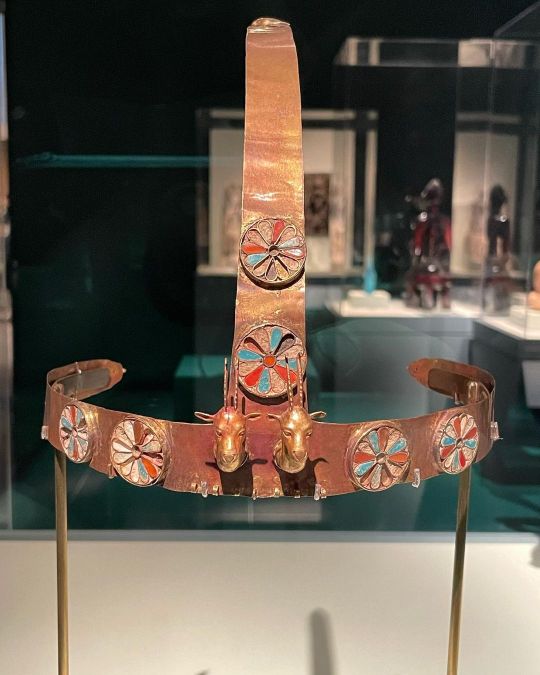
Diadem with a Pair of Gazelle Heads (ca. 1479–1425 B.C.) New Kingdom During her lifetime 𓊢𓂝𓂻 “ˁḥˁ”, a queen 𓇓𓈞𓏏𓅨𓂋𓏏 “ḥm.t-n(y)-sw-wr.ṯ” wore this delicate diadem 𓈍𓏲𓋖 “ḫˁ” tied over her wig 𓈖𓃀𓅡𓄿𓁸 “nb3”. The headband not only identified her elite rank but also identified her as a woman 𓊃𓏏𓁐 “s.t” participating in a cultic performance. Tomb depictions illustrate high-ranking women wearing similar ornaments when they took part in rituals that likely honored important goddesses 𓊹𓏏 “nṯr.t” like 𓏇𓇋 “mı͗” Hathor 𓉡 “ḥw.t-ḥr”, Mut 𓏏𓅑𓁐 “mt” or Sekhmet 𓌂𓐍𓅓𓏏𓆗 “sḫm.t”. The reason for depicting gazelles 𓂾𓋴𓃲𓏪 “gs.w” is not clear, although they are associated with the sun god 𓂋𓂝𓁜 “rˁ”, fertility, and rebirth 𓆣𓂋𓇌 “ḫpri”—all subjects connected to these great 𓉼𓂝𓄿𓏜 “ˁ3” goddesses. Gazelles inhabit the low desert 𓅱𓂝𓂋𓏏𓈊 “wˁr.t” along the edge of the Nile’s 𓎛𓂝𓊪𓏭𓈘𓈗 “ḥpy” floodplain, often traveling 𓈖𓌰𓅓𓂻 “nmı͗” in pairs. This habitat probably explains why these animals figure prominently in a significant myth about the goddesses that takes place in that setting. Period: New Kingdom Dynasty: Dynasty 18, early Reign: reign of Thutmose III Date: ca. 1479–1425 B.C. Geography: From Egypt, Upper Egypt, Thebes, Wadi Gabbanat el-Qurud, Wadi D, Tomb of the Three Foreign Wives of Thutmose III Medium: Gold, carnelian, opaque turquoise glass, decayed crizzled glass Dimensions: L. of forehead band 48 cm (18 7/8 in.); W. at bottom of vertical strip 3 cm (1 1/8 in.) 📸 @egyptologylessons © (@metmuseum and description) #Ancienthistory #historyfacts #historylovers #ancientegypt #hieroglyphics #ägypten #egyptologist #egyptianhistory #egyptology #hieroglyphs #egypte #egyptians #egitto #埃及 #مصر #egipto #이집트 #art #culture #history #diadem #thutmosesiii #crown #gazelle https://www.instagram.com/p/CaKXfQLrhRp/?utm_medium=tumblr
#ancienthistory#historyfacts#historylovers#ancientegypt#hieroglyphics#ägypten#egyptologist#egyptianhistory#egyptology#hieroglyphs#egypte#egyptians#egitto#埃及#مصر#egipto#이집트#art#culture#history#diadem#thutmosesiii#crown#gazelle
16 notes
·
View notes